The trouble with Women Pirates…
Table of Contents
- …a wondrous, not monstrous regiment, including spies, sex workers and pirate queens
- How ever did you come to write about women pirates, of all things?
- Women are rare because today’s piracy business is ruthlessly masculine
- Looking for modern women pirates made me very aware that piracy was serious, not fun
- Should we be glad that there were real women pirates, albeit so few?
- Need to Know…
What could be sassier, you might think, than a bold, sexy buccaneer? Slightly dykey and into a light-hearted touch of woman-led bondage. Brandishing—but with a beautiful smile—a long whip to go with that lethal cutlass. And mmmmm, swashbuckling along the deck in those sea-washed, thigh-high leather boots. She could shiver anyone’s timbers. Geena Davis as Morgan Adams in Cutthroat Island, (1995) is a scintillating example of the genre. Keira Knightly in The Pirates of the Caribbean (2003-2007) could also wield a sword with lethal prettiness.
The (interesting) trouble is that such images of women pirates are a fantasy. Exploring such a fantasy not only requires—but also reveals—a broader knowledge of just why it is that the sea is popularly seen as a ruggedly masculine space in which real seawomen have only small, strictly prescribed, walk-on parts. After all, woman’s traditional place is in that kitchen on land. More widely, fantasies of women pirates help us to understand the differing human needs for renegade heroines, and also the exceptionality of the oceans. Why is it that more extraordinary things are allowed to happen at sea than on land?
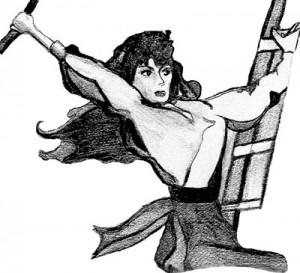 My own interest in women pirates began as a small part of my enduring research into women who seized a chance for some kind of freedom and exceptional mobility through sailing. In the early 1980s I found that there had, indeed, been those unicorns—women seafarers—although they comprised less than one per cent of the maritime workforce. So women and the sea were not completely opposing categories.
My own interest in women pirates began as a small part of my enduring research into women who seized a chance for some kind of freedom and exceptional mobility through sailing. In the early 1980s I found that there had, indeed, been those unicorns—women seafarers—although they comprised less than one per cent of the maritime workforce. So women and the sea were not completely opposing categories.
…a wondrous, not monstrous regiment, including spies, sex workers and pirate queens
No modern history had been written about women working on ships at the time when I began interviewing them. However the first works about women’s segregated occupations on land were emerging fast: secretaries, pottery workers, and factory hands. Trying out that new term ‘herstory’, women’s history was being uncovered and assessed with great vigour. Like beacons of a new dawn, feminist publishing houses such as Virago, Women’s Press and Pandora, and bookshops such as SisterWrite and Silver Moon, enabled the dissemination of herstories, novels, poems and plays about a wondrous, not monstrous, regiment including spies, sex workers and pirate queens. And feminist historians overseas were, unknown to each other, doing serious parallel work that began exploring life on misogynist but unexpectedly women-filled ships. In 1989 the first ones emerged: Diane Dugaw’s book on cross-dressed women sailors in balladry; then in 1991 and 1992 Joan Druett’s books on whaling women. By the time my Bold in Her Breeches: Women Pirates Across the Ages came out in 1995 more work was emerging: Suzanne Stark’s on naval women and Creighton and Norling’s still-seminal work on gender and the sea, both published in 1996.
How ever did you come to write about women pirates, of all things?
‘How ever did you come to write about women pirates, of all things?’ people ask. Well, because of that instinct possessed by historians of hidden history: ‘If there are all these men/whites/straights/elites around, then there has got to be another story too—of the marginalised, the Othered.’ In my case, while researching worthy ships matrons in the National Maritime Museum library, I accidentally found yards of books on pirates like Blackbeard and their Hispaniola molls. I then realised how many Hollywood movies starring swashbucklers like Errol Flynn featured women as damsels-in-distress. So surely in all these secondary roles for women, there had to be some women who were actually pirates themselves.
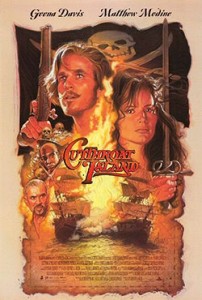
Poster for Cutthroat Island(1995) featuring Geena Davis
But how do you find a woman pirate? You look in the piracy industry. The piracy industry as recorded presents problems. There are two sorts of works about piracy. Early histories are full of implausible, glorying stories of daring figures, particularly in the main source, Captain Charles Johnson (whom many—tellingly—thought to be novelist Daniel Defoe). In his 1724 General History of the Robberies & Murders of the Most Notorious Pirates and similar texts, the rare women are amazingly bloodthirsty but luscious cross-dressers—and there is no discussion of gender relations.
By contrast the second sort of work on piracy, modern reports, are business-focused. It’s no accident that the main pirate-tracking organisation, the International Maritime Bureau, is a division of the International Chamber Of Commerce. Long before recent media revelations about modern Somali ocean thugs undermined the Johnny Depp version of glam piracy, the IMB’s reports have been consistently concerned about third-world desperados. Such pirates’ crimes cause headaches for maritime insurers. They lead seafaring unions to debate whether to arm ships’ personnel would save lives or just worsen the danger. Today’s booty is not casks of aged madeira wine, velvet and gold doubloons, but easily sold-on MP3 players, mobile phones and arms, as well as crew credit cards, iron ore pellets and even entire ships. Pirates are often ex-military toughos, wearing military fatigues, flip-flops and Mickey Mouse T-shirts, not feathered hats and brocade waistcoats. They use rocket-propelled grenades not cutlasses.
Women are rare because today’s piracy business is ruthlessly masculine
Women are rare because today’s piracy business is ruthlessly masculine. A number of pirates are Moslem, which means a woman’s place could never be at the outboard motor. However, experts guess that some non-mainland Chinese women in shipping offices round Singapore may be involved from afar. It’s thought that they covertly give pirates information about a vessel’s cargos, routes, the time when it has crew wages aboard and even the code for the captain’s safe.
Principal women pirates:
Women working in their own right
Artemisia, Queen of Halicarnassus (now Bodrum, Turkey). (Active 480 BC). A widow aged forty-plus, and ship-owner, she is termed a pirate but really was more of an admiral’s assistant in the Battle of Salamis. She assisted Xerxes as strategist and commanded a trireme (fighting ship) that rammed other ships.
Alfhild/ Alwilda. This fifth-century Danish daughter of a Goth king is probably a myth like the Shield Maidens. She allegedly captained an all-woman pirate ship that sailed for several months. Then her fleet engaged with that of her rejected suitor, Alf, who ‘seeing the smoothness of her chin, saw he must fight with kisses and not with arms.’ Lo, he won after all and ‘made her change her man’s apparel to a woman’s; and afterwards begot on her a daughter, Gurid.’ (Quote from The First Nine Books of Saxo Grammaticus, translated by Elton and Nott, 1894.)
Granuaille/Grace O’Malley/ Gráinne Ní Mháille. (c.1530- c.1603). From a wealthy Irish family in maritime trade, her ships held up trading vessels and made them pay for safe passage. Resisters could be murdered. She allegedly gave birth on a ship engaged in battle. Her piratical behaviour—on land and sea—was certainly connected to her two husbands’ and her family’s rapacious practices. She captained her own (male-crewed) ships with great strategic skills, and was known to be female.
Mary Read (c.1690-c1720). Born to a sea captain’s widow, she was cross-dressed by her mother to extort money for a ‘son’ from the in-laws. Mary joined the army as a footboy, became a pub landlady, then a privateer (1618), and finally worked for pirate Captain ‘Calico Jack’ Rackham during which time she also managed a relationship with a male shipmate. She and Anne Bonny were both captured in 1720 in a major piracy round-up. It’s thought she died in prison of puerperal fever.
We might see the situation as akin to the way women in combat are only uncovered when the media reveals that these apparent exceptions to all-male rules have been caught or killed. Obvious examples are Leading Seaman Faye Turney, who was captured in Iranian waters in March 2007 or Corporal Sarah Bryant, the first British servicewoman killed in Afghanistan in June 2008.
Given the tiny amount of hard information about real women pirates’ lives and contexts, to build a picture we need to take the flimsy, fantasy-fuelled fragments we have and put them into a bigger frame. This requires looking at the context of gender relations in the piracy business and seafaring generally, in segregated workplaces, and in criminal subcultures. Looking at historical women pirates means disentangling the glorifying myths from the distressing reality of maritime crime. It’s also useful to have knowledge about today’s women’s struggles to work on ships, including in state navies where women face harassment and exclusionary practices such as banning women from deployment on submarines. Then we can see how exceptional women pirates were, and how predictably they were treated on ninety-nine per cent male ships.
Despite all odds, there were at least thirteen recorded women pirates, from 480 BC to 1993. They certainly were involved in fighting, they certainly were ruthless, and a few ended up wealthy. Some were captured and jailed, but none were executed. Most were in their twenties and thirties. Like most pirates their careers were short (significantly less than ten years). Some were white and some Chinese. African and South Asian woman pirates are yet to be uncovered. Some were broadly working-class in origin, even working as prostitutes or in petty fraud. And one is popularly seen as a lesbian. Anne Bonney propositioned the cross-dressed Mary Read, who then felt she had to reveal her ‘incapacity’, her lack of a penis. Various versions suggest they became lovers despite this. The majority of women pirates had at least one child, even in the period when they were active pirates. This was particularly possible for Chinese women as whole families sailed.
One of the key distinctions is between those women who were pirates in their own right, and those who were in the business because of their sexual attachment to a senior man (as panels one and two show).
Looking for modern women pirates made me very aware that piracy was serious, not fun
For Bold in her Breeches I researched and wrote twelve of the fifteen chapters myself and asked experts on particular periods and women to write on their subject. This seemed more respectful of their knowledge. Then I wove their sections together to suggest ways we might understand women pirates’ contexts.
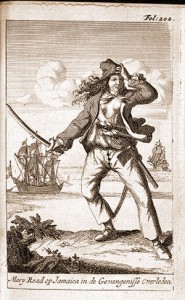
Image of Mary Read (1725). By courtesy of the British Library
Looking for modern women pirates made me very aware that piracy was serious, not fun. I tried to interview Susan Frani in a Manila jail. Sweating in the Philippines was arduous work. I found ‘pirate brokers’ had to be hired. ‘You’ll have to make a very big contribution to “prison warders’ charities”’ I was told. ‘And you’ll have to hire two bodyguards, the second one because the first one might double-cross you.’ Experts also warned there was no guarantee that Frani would even talk to me if I could see her. Indeed, how much would I understand, in a country where ‘English-speaking’ means using such heavily Tagalog-accented American that we barely understood each other? Three expensive weeks passed in that gun-toting city when finally a British diplomat advised me to give up. That was hard for an oral historian who loves asking seafaring women about their experiences. But this time around I had to accept that I could not ask one single real pirate to her face ‘why do you do it, what’s it like, how do the guys treat you, how is it different for a woman?’
Bold in her Breeches did very well, hitting the heights of the alternative best-sellers charts. It was pleasing to see the piles in Silver Moon’s window. For a week the publisher’s limousine came to take me to radio studios. The book is translated into Japanese too and it’s frequently used by students. I feel proud, and still think it’s the most grounded book so far on women pirates. Film-makers and TV producers often approach me saying they want to put women pirates on screen (they later give up after finding that hiring or building ships costs too much—something that the producers of loss-making Cutthroat Island discovered to their cost.)
Principal women pirates:
Partners of pirate leaders
Anne Bonney (1700-1720 or 22). From Cork, her housemaid mother cross-dressed her for gain. Later emigrated to Carolina, where she became lover of Captain Calico Jack Rackham and mother of his child. Sailed as a woman, fancied Mary Read. Captured 1720.
Maria Cobham (Born 1695?). Former Plymouth prostitute who sailed with husband, Charles, committing piracy. She created much antagonism on ship by interfering with his disciplinary practice (she was over-harsh). When their piracy career ended, he became a magistrate in Le Havre; she overdosed on laudanum.
Ching Yih Sao (1775-1844). Former Canton prostitute who sailed the South China Seas. She married a pirate captain in 1801 and when widowed in 1807 commanded a confederation of 70,000 men and 400 junks. Pardoned in 1810 and went on to run an infamous casino.
Lai Choi San (c.1890 – c.1940). Her father’s business was piracy in 1920s Macao and she married her father’s favourite. After being widowed, she inherited twelve armoured junks and used them to extort protection money from fishing people.
Lo Hon Cho (Active in the 1920s). When widowed, she took over her husband’s business, operating sixty junks around Pakhoi (now Beihai). She raided shore communities and sold captured girls into slavery. She is also said to have worked with Chinese revolutionaries.
Susan Frani (c.1960 - ?). Her exact role in Filipino piracy is unclear; she was possibly ‘Maid Marion’ to ‘Robin Hood’ Emile Changco. Frani was arrested and jailed in Manila in 1993.
Occasionally I give talks on women pirates. It feels like it’s my job to disillusion people who want to imagine women pirates as girl-power groovers or dominatrices. Knowing shipboard culture, it seems that the reality is more likely that women pirates were mostly victims who mixed with the equivalent of disaffected mini-cab drivers, petty crooks and mercenaries. But the myth is fun, because it’s so much about unconfined women. And I happily dress up in pirate gear for press photos, picking up eye-patches from the local Boots and borrowing cutlasses from obliging museums. Kinksters fantasise about meeting me and being made to walk the plank. But really, women pirates have to be understood as seafarers, as opportunists (as most thieves are) and as part of a floating criminal world. I don’t see the glamour in that.
These days I research women sailing in all sorts of roles—as liner hairdressers and medical staff, and as travelling ayahs (child care workers) in the Raj. My next book, to be published later this year by Yale University Press, is on women at sea in WW1 and WW2. I also work on lesbian, gay, bisexual and transgendered people at sea, for example in the travelling exhibition, called Hello Sailor!, created by Merseyside Maritime Museum. A colleague joked that such work could be called ‘Bold in their Petticoats’, in a pastiche of Bold in her Breeches. The story of camp gay men on ship, like women’s piracy, can be read as a story of the transgressions of gender norms in which clothes play an important symbolic role. It’s fascinating to see how ships function as exceptional spaces in which the extraordinary can happen, and yet the social mores of land still operate.
Since the early 1990s solid historical work is being done on women/gender and the sea, on ships of all kinds. It offers information that seems to verify my hunches about women pirates’ position. Firstly, it seems that women thrive best on ships if they are connected to the senior power figure in the organisation, for example as the patriarch’s wife. Secondly, people of lowly rank on ship—such as boys and camp men—can be exploited as recipients of casual sexual attention from butch men, because being on voyages seems to bring out desires and anxieties about power. And thirdly, women are objectified and sexualised rather than treated as equal colleagues; their career prospects are poor.
The fascination with women pirates runs and runs. There’s usually a gleam in people’s eye when they ask ‘were there women pirates then?’ Lecturing on a recent cruise, I found the tensions between admiring fantasy pirates and dealing with their reality were still apparent. The kids had a great time dressing up gorily on Pirate Day. Concessionaires running the photo studio even had specially printed buccaneer mounts to frame the pictures. But the captain himself told me that one of the regrettable aspects of piracy is that mariners can’t afford to obey the comradely law of the sea and help a small ship in trouble. He couldn’t risk the ship, in case those seemingly distraught refugees turned out to be pirates in disguise.
Five FAQs.
1. When and where? The main known women pirates (three) were sailing in the so-called Golden Age, up to 1720, when pirates were besieging the seaways between South American treasure fields and the Spanish mainland.
2. Who’s tops? Anne Bonney and Mary Read are the two best known—not least because their story was given away free on cards in Weetabix packets.
3. Were women pirates always in breeches? No, not necessarily. Some were cross-dressed to hide their feminine identity, partly for safety. Others just donned trousers when they were about to fight, because voluminous petticoats would have hampered them.
4. How did they cope with periods if they were pretending to be men? It’s thought that they may not have menstruated (as their diet meant they had too little body fat) or that colleagues just assumed they were wounded. Some cross-dressed women urinated through a horn.
5. Were they tough? Yes, they had to be, especially if they were not top of the ship’s callous pecking order. But the blood-thirstiness is probably overplayed. Anne Bonney is famous for telling Jack ‘if you’d have fought like a man you would not have been dying like a dog.’
Should we be glad that there were real women pirates, albeit so few?
I wish I had a fiver for everyone who has asked me would I like to have been a woman pirate. The answer is that I’d be quite interested to be the mythical sort, with all that power. But I wouldn’t like to be a real one, thank you. I enjoy my (dry) home comforts, some job security, my dignity and my freedom from anxiety that colleagues might rape or dump me.
Should we be glad that there were real women pirates, albeit so few? Well, perhaps no, because pirates of any sex are a menace. And maybe the job was bad for the women pirates themselves. Recent Ministry of Defence findings indicate that being in violent front-line situations is far worse for women’s mental health than it is for men. But yes, we could be glad, because by their existence women pirates provide proof that women can be competently and daringly at sea. They perhaps paved the way for the many cross-dressed women sailors who sailed in subsequent centuries, even though it is tragic that women on ships could not work openly as women.
Women pirates are a useful, if limited, strand in the larger study of gendered maritime histories. They help us see what difference it makes to women’s lives to be away from home and land.
By far the most interesting way to consider women pirates is as follows: as unusually mobile women for their period; as part of that interesting pattern whereby people at sea dare to be other than their usual selves and dress transgressively; and as women doing ‘men’s jobs’ on ships. In that way they are, indeed, our fascinating fore-sisters.
Need to Know…
Dr Jo Stanley, FRHS, is a writer and consultant about gender and the sea. She is Honorary Research Fellow at Lancaster University’s Centre for Mobilities Research. Visit Jo’s website www.jostanley.biz and her blogsite www.genderedseas.blogspot.com
Jo’s book, Bold in Her Breeches: Women Pirates Across the Ages![]() , was published by Pandora/Rivers Oram in 2003. Also of interest, and/or referenced in Jo’s article, include
, was published by Pandora/Rivers Oram in 2003. Also of interest, and/or referenced in Jo’s article, include
Fiona Cooper, The Empress of the Seven Oceans![]() (Black Swan, 1993). This is an improbable but popular romp. Highly entertaining - check the link for second hand editions from Amazon.
(Black Swan, 1993). This is an improbable but popular romp. Highly entertaining - check the link for second hand editions from Amazon.
Margaret S Creighton and Lisa Norling (eds.), Iron Men, Wooden Women: Gender and Seafaring in the Atlantic World 1700-1920 (Gender Relations in the American Experience)![]() (Johns Hopkins Press, 1996)
(Johns Hopkins Press, 1996)
Joan Druett, Petticoat Whalers: Whaling Wives at Sea, 1820-1920![]() (Collins/Auckland, 1991) and ‘She Was a Sister Sailor’: The Whaling Journals of Mary Brewster, 1845-1851 (Mystic/Connecticut 1992)
(Collins/Auckland, 1991) and ‘She Was a Sister Sailor’: The Whaling Journals of Mary Brewster, 1845-1851 (Mystic/Connecticut 1992)
Dianne Dugaw, Warrior Women and Popular Balladry, 1650-1850![]() (Cambridge University Press, 1989)
(Cambridge University Press, 1989)
Steve Gooch, Women Pirates: Ann Bonney and Mary Read (Pluto plays)![]() (Pluto Press, 1978)
(Pluto Press, 1978)
Suzanne J Stark, Female Tars: Women Aboard Ship in the Age of Sail![]() , Naval Institute Press/ Annapolis, 1996)
, Naval Institute Press/ Annapolis, 1996)




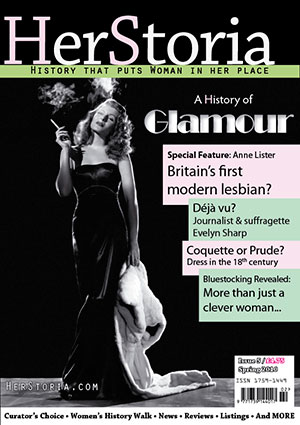
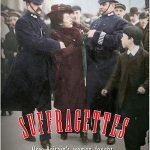


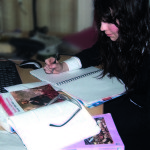
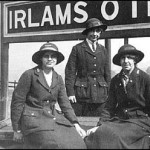
[…] student or wanting an excellent introduction to the topic. There’s a good follow-up piece by her here. As she says, we have to ask who counts as a pirate? This seeming innocuous question uncovers the […]